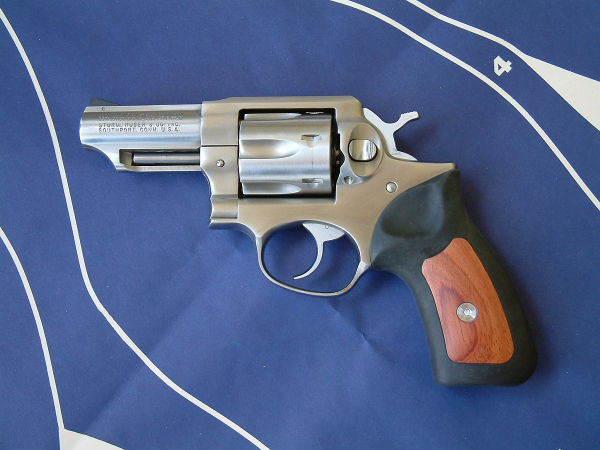
I’ve been a fan of Ruger DA revolvers since the mid-1970s. I started out with a four-inch stainless Security Six. It was a fairly early issue and I let it get away. After Charles A. (Skeeter) Skelton reported on the newer heavy barrel Security Six line, I went searching. I found a stainless example at Ryder’s Sporting Goods in Arma KS. It went home with me and ended up in a police holster.
With its four-inch heavy barrel and smooth-faced trigger, I expected good things from it. Jim Clark of Louisiana was marketing a flat-faced adjustable rear sight for Security Six revolvers and I got a spurless Speed-Six style hammer from Gil Hebard Guns. I fitted both up and crowned the creation with Hogue Monogrips. I carried that .357 Magnum for quite a few miles, usually in uniform carried in a Bianchi Judge holster.
The newer Security Six had a far better DA trigger pull than its ancestor. It was easy to shoot quite well. I put a lot of rounds through that gun and it never let me down. It was every bit the better of my mediocre skills. I made shots with that gun that I never should have been able to make. Alas, I let it get away from me.
Since then, the Speed- and Security series dropped from view. Along with the advent of the Ruger Redhawk and the SP-101, we got the GP100 – according to the serial number history page, in 1986.
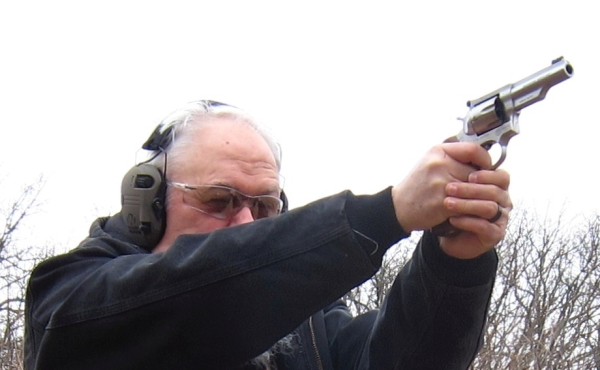
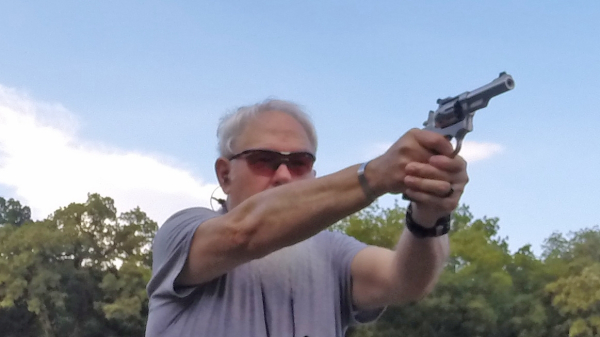
On that same page, it shows that the GP100 has been made in .22 LR, 327 Federal Magnum, 38 Special, 357 Magnum, 10mm Auto and 44 Special. In this century, I’ve made use of the GP in 22, 357 and 10mm. I’ve not had the privilege of the 44 Special and found the 10mm to be a handful.
In 22, it’s a 10-shot gun and, by use of a rather incredibly heavy DA trigger, it’s one of the best trigger control trainer guns I’ve ever used. You have to pay attention to keep that muzzle still as you trigger cock-and-fire that heavy small-bore. It’s one of my favorite range guns and it’d make a great field gun too.
Conversely, the 357 and 10mm guns had sweet DA triggers, easy to handle. A close friend has a repatriated 38 Special (only) GP100 from a foreign contract; it likewise has a very nice DA trigger.
The first GP100 I got ahold of was the KGPF-330, six-shot 357 with a 3-inch partly lugged barrel. It is fabricated of stainless steel and weighs about 35 ounces unloaded. I fired Black Hills 125 grain JHP on a 25-yard accuracy test. The load put five hits into only 3 13/16”. The best three hammered into only an inch and a half.
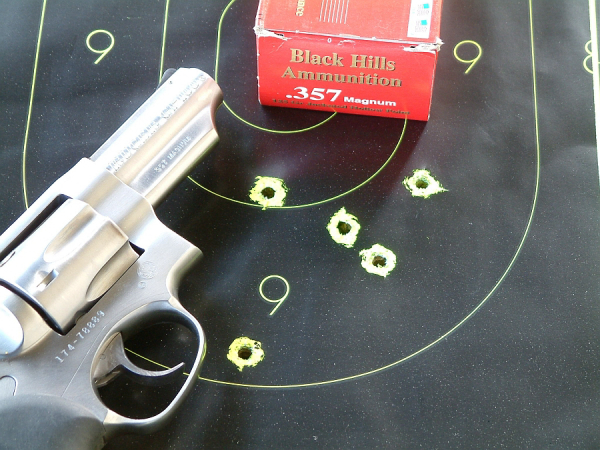

Like earlier Ruger revolvers, the GP has a frame-mounted firing pin and transfer bar safety. The trigger has to be pressed to push the transfer bar into alignment, allowing the strike of the hammer to be transmitted to the firing pin.
The hammer spring (mainspring) is a coil spring. The trigger group is mounted into the trigger guard unit. The cylinder release is a push button on the left side of the receiver. The cylinder locks in the rear and forward, on the crane. There is no real grip frame, but a stud that contains the mainspring unit. The stocks are made of rubber with rosewood inserts.
The leather I used with that 3” fixed sight gun was from Don Hume, their H721 OT. Also known as the “Double Nine,” it’s an open top rig. It has a natural, saddle tan finish with white stitching. The belt slots are extended beyond the holster pouch front and back. They are covered. The resulting effect is a “pancake-“style holster that fits closely to the wearer.
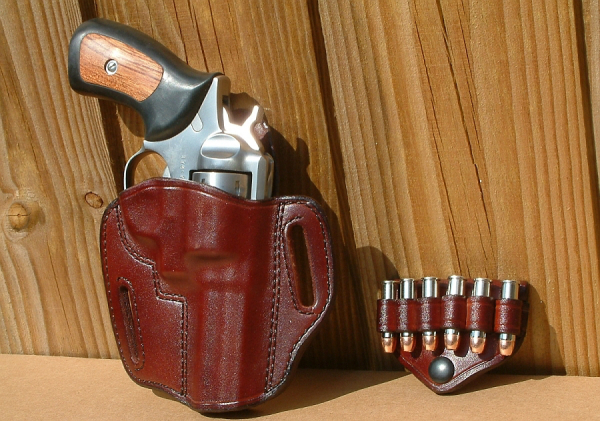
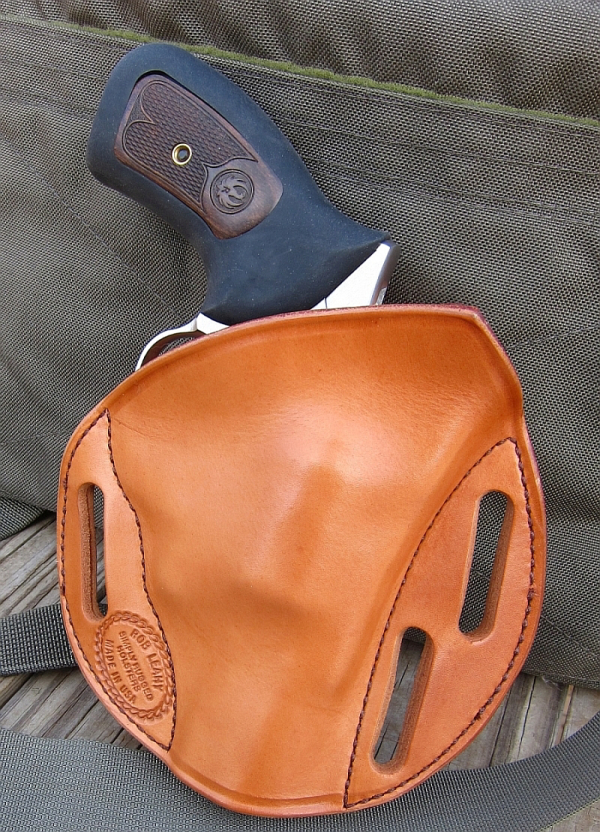
One of the more recent GP100s to arrive was the seven-shot 357 snub – featuring a 2 ½” barrel. I carry the snub in the Simply Rugged Sourdough Pancake. Like the Roy Baker Pancake holster that Rob Leahy (the Simply Rugged Holster proprietor) credits for this design, the Sourdough wraps around the body and uses that lateral tension to bring the butt of the gun in tightly.
I was recently asked what good is a snub 357 Magnum like the GP100 – a few recent events brought home a fair response. One was being present while a police firearms instructor worked with a student struggling with trigger control. They issue one of the current plastic autos with a reasonable trigger for a striker fired gun. Using the 22 GP100 and the Claude Werner version of the ‘ball and dummy’ helped ease the student into a credible performance. Using the snub with its vastly easier trigger would have made it a bit easier.
Colleague and friend Michael Bane reported that he lives in an area where they’ve been cautioned about mountain lions working in close to human habitation with some resulting issues. At the same time, a nearby friend reported that he’d killed six coyotes over the past nine weeks – in a reasonably rural yet well populated area that hasn’t seen that level of predator activity in many years.
While the fifteen-shot 9mm I usually carry would work out fine for either of those wildlife situations, I’d likewise be okay with seven shots of 38 +P or 357 in the snub GP100 for that kind of engagement.
It’s no longer a revolver world, but the world’s not done with revolvers yet. The proliferation of the GP100 is evidence of that.
- - Rich Grassi